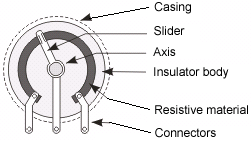|
|
||
|
Potentiometers (also called pots) are variable resistors, used as voltage or current regulators in electronic circuits. By means of construction, they can be divided into 2 groups: coated and coiled. With coated potentiometers, insulator body is coated with a resistive material. There is an elastic, conductive slider moving across the resistive layer, increasing the resistance between slider and one end of pot, while decreasing the resistance between slider and the other end of pot.
Coated potentiometer Coiled potentiometers are made of conductor wire coiled around insulator body. There is an elastic, conductive slider moving across the wire, increasing the resistance between slider and one end of pot, while decreasing the resistance between slider and the other end of pot. Coated pots are much more common variant. With these, resistance can be linear, logarithmic, inverse-logarithmic or other function depending upon the angle or position of the slider. Most common are linear and logarithmic potentiometers, and the most common applications are radio-receivers, audio amplifiers, and similar devices where pots are used for adjusting the volume, tone, balance, etc. Coiled potentiometers are used in devices which require increased accuracy and constancy of attributes. They feature higher dissipation than coated pots, and are therefore a necessity in high current circuits. Potentiometer resistance is commonly of E6 series, most frequently used multipliers including 1, 2.2 and 4.7. Standard tolerance values include 30%, 20%, 10% (and 5% for coiled pots). ►Ohm's Law
|
||
|
|
||
